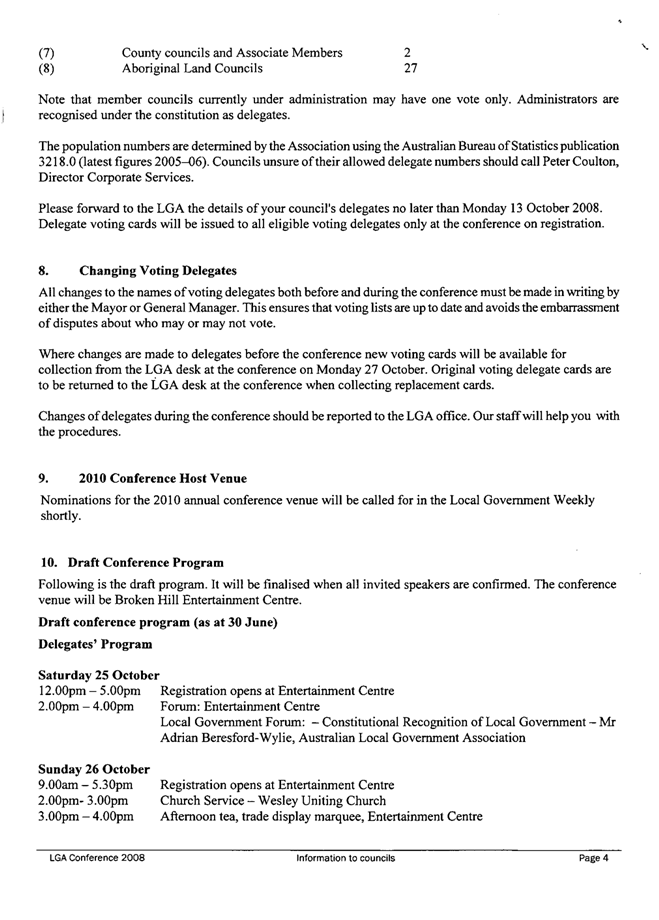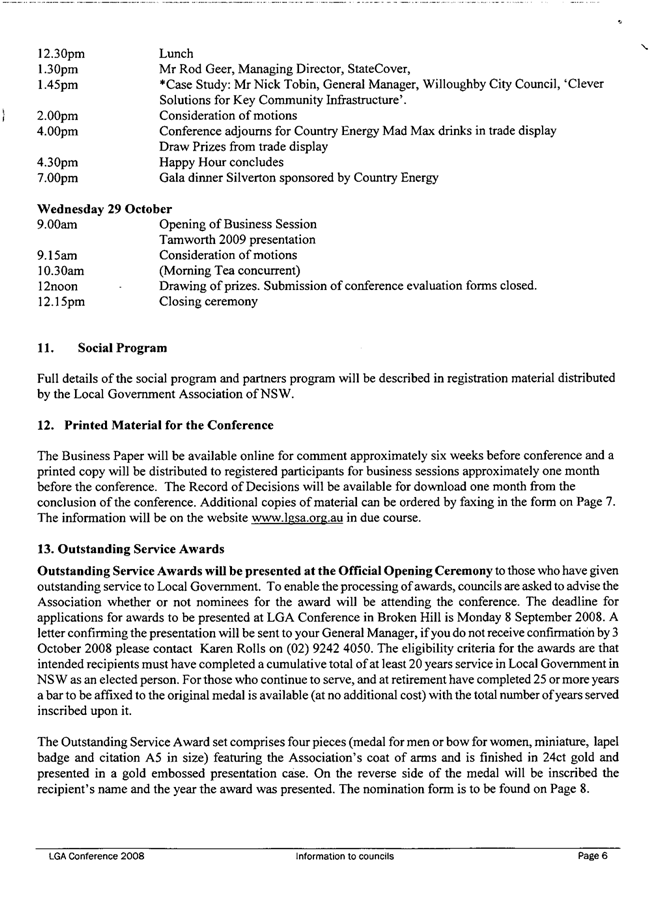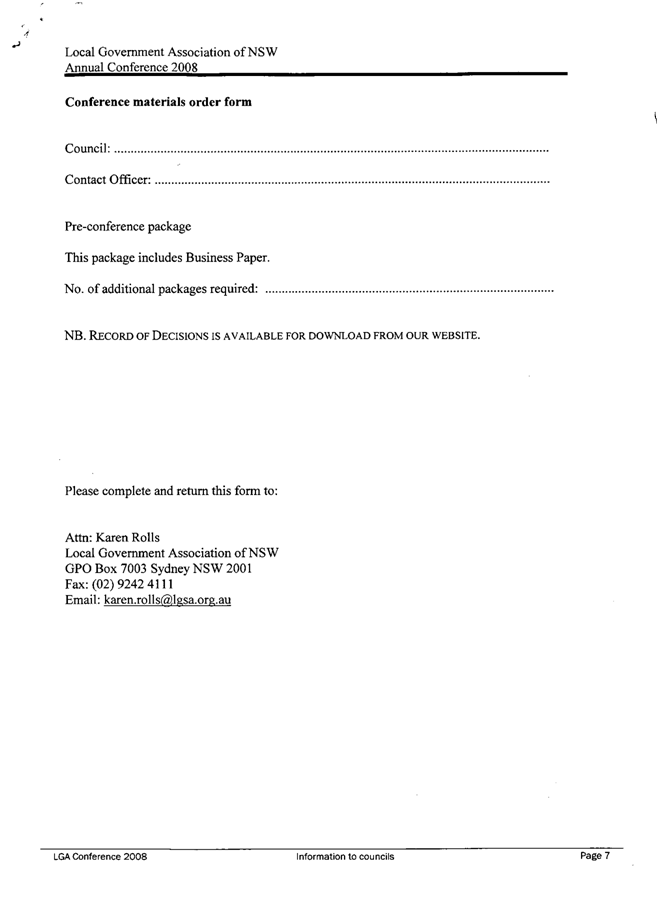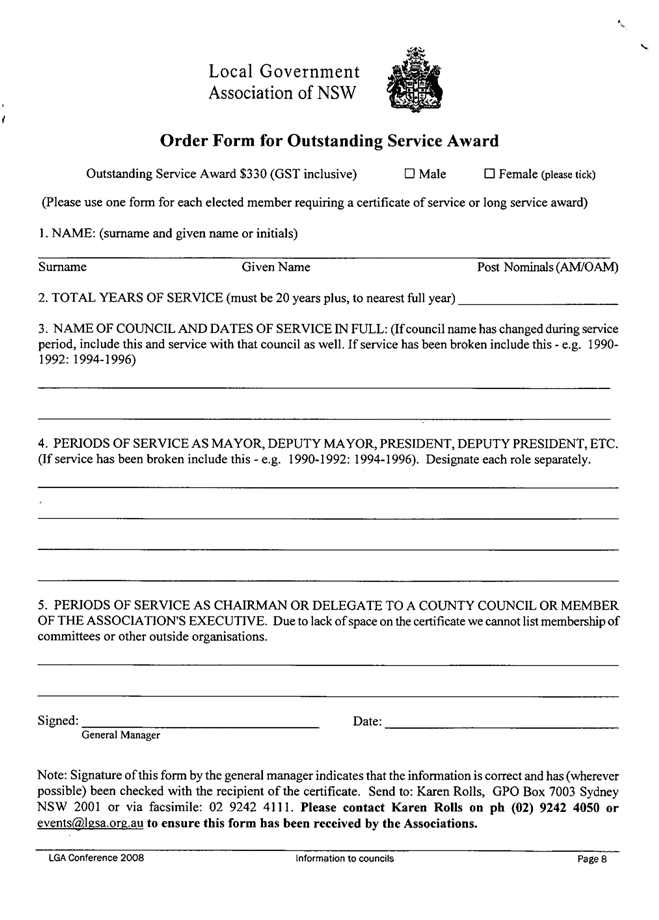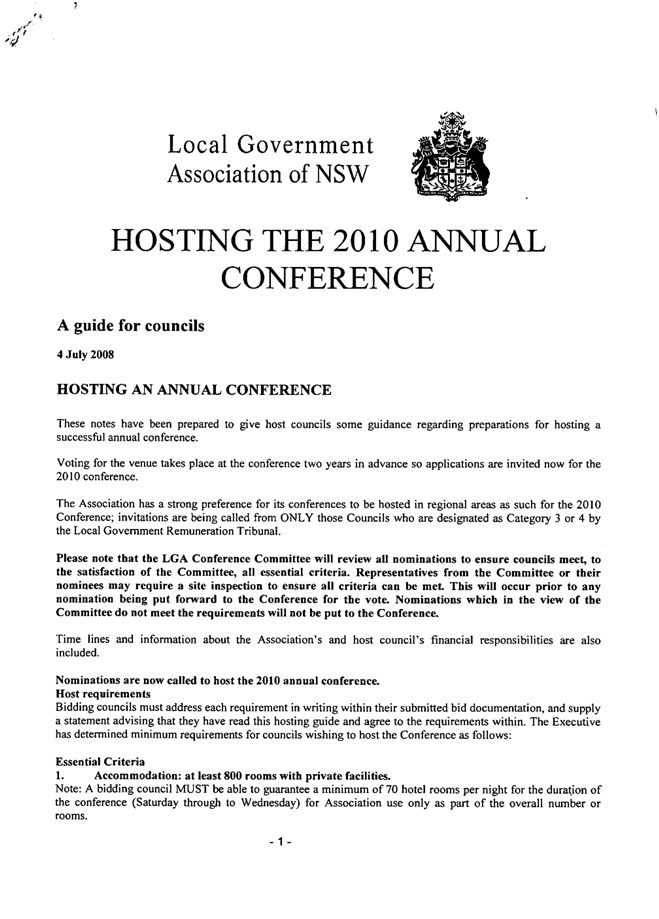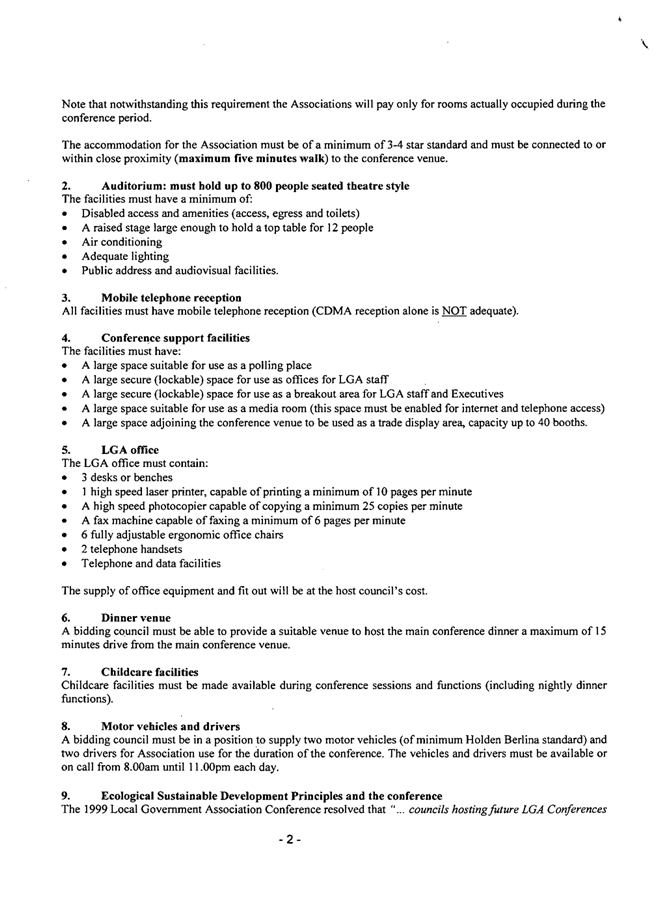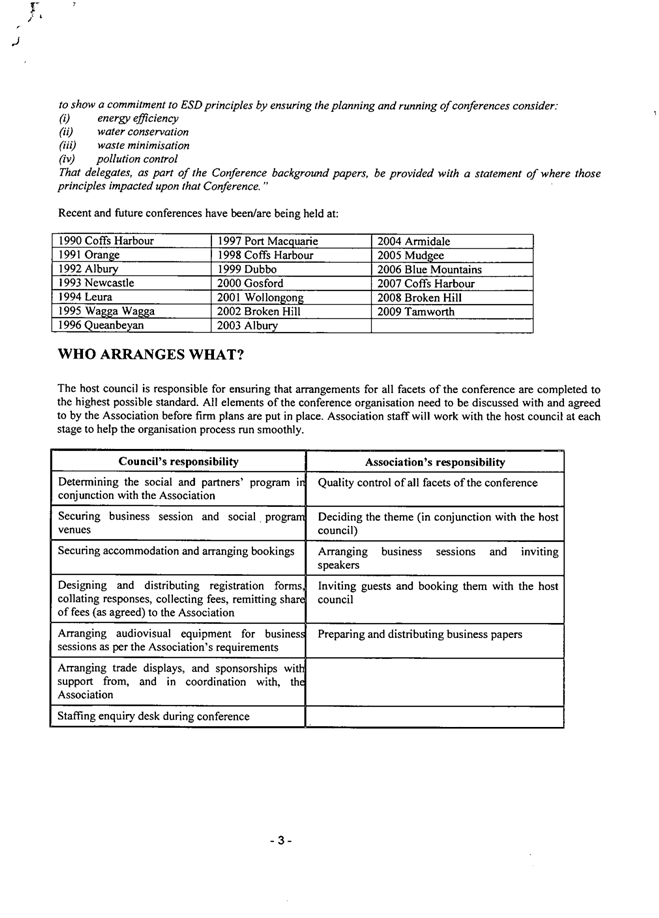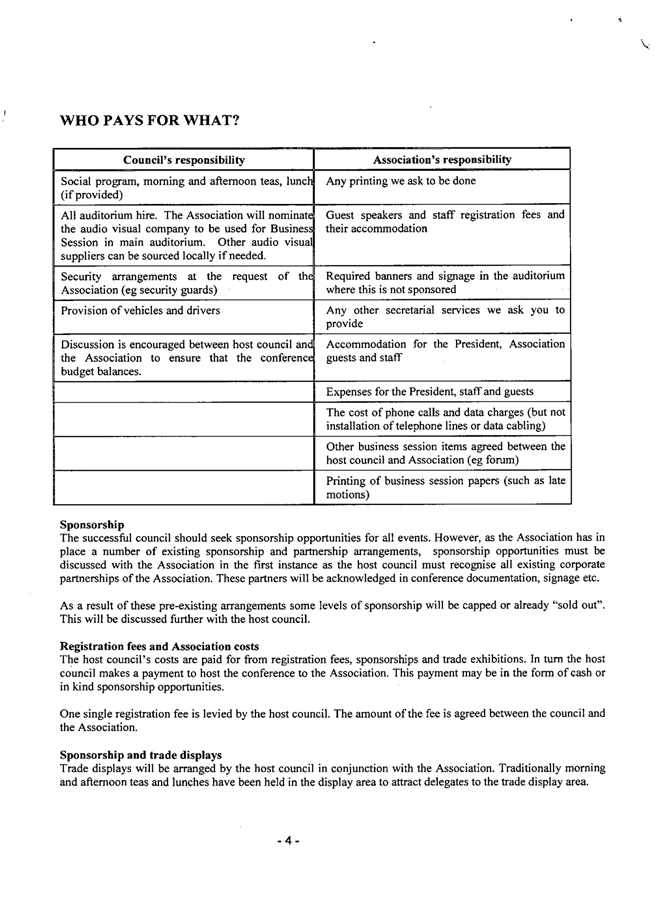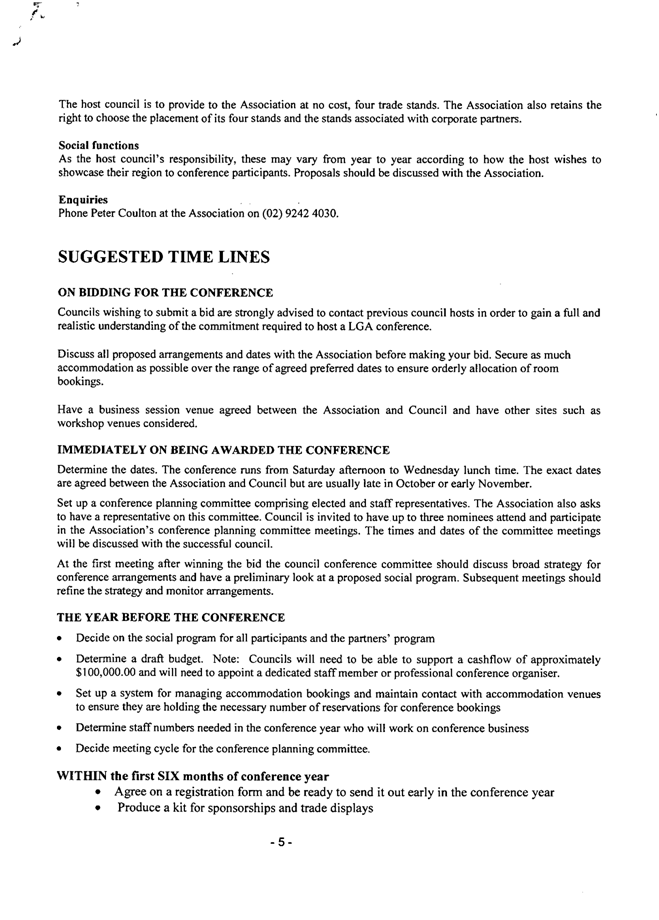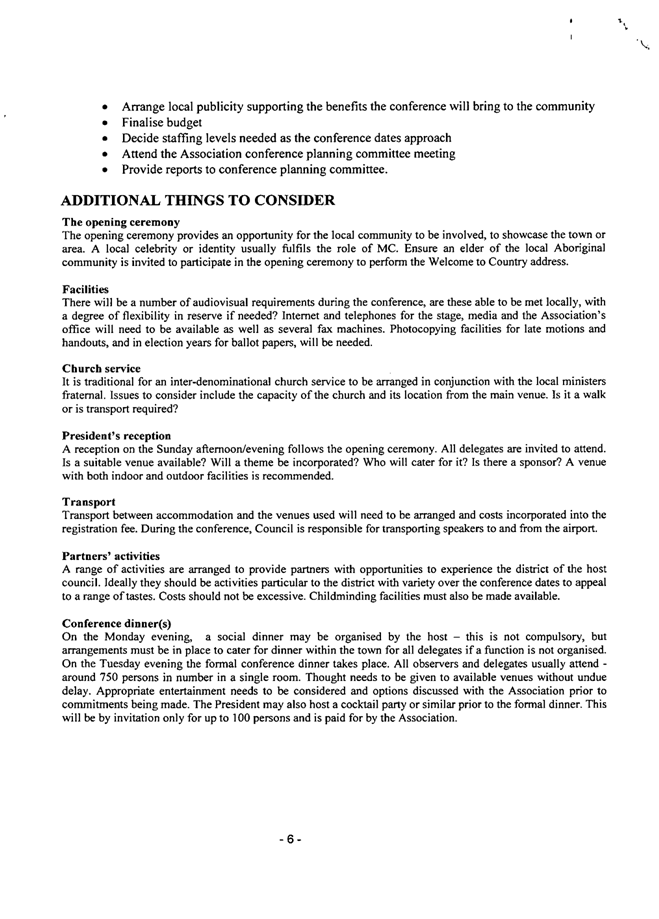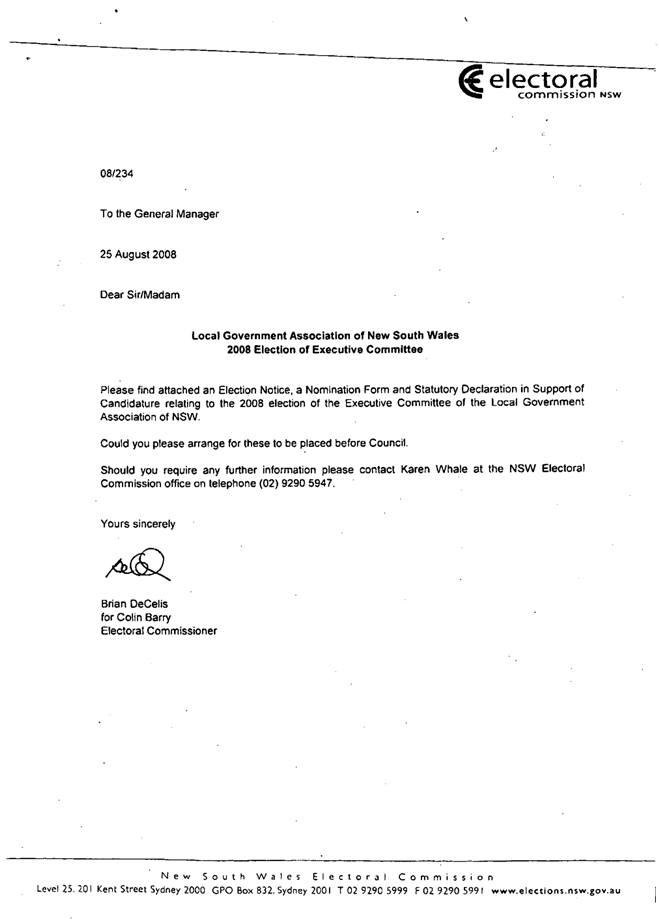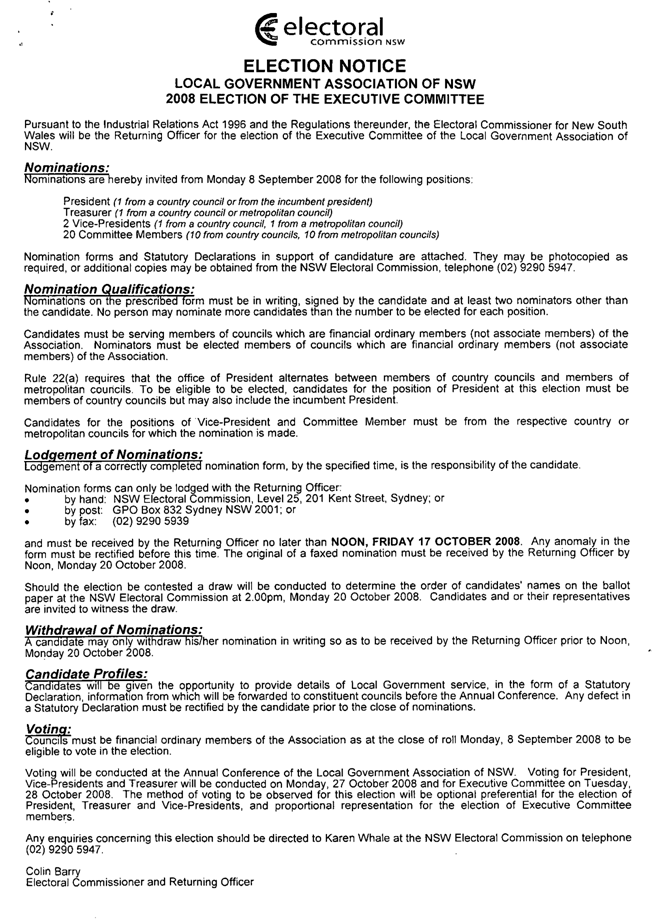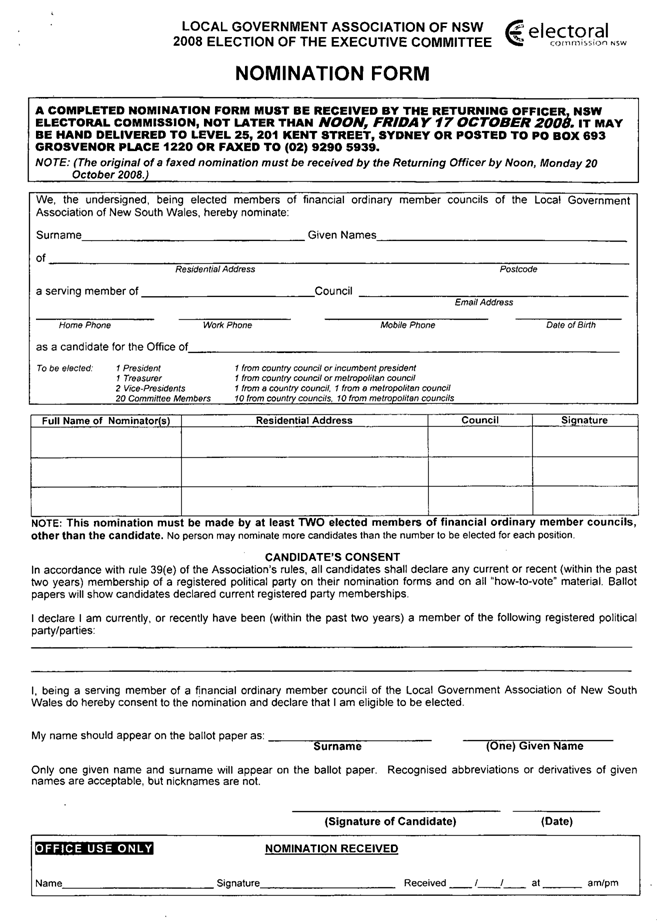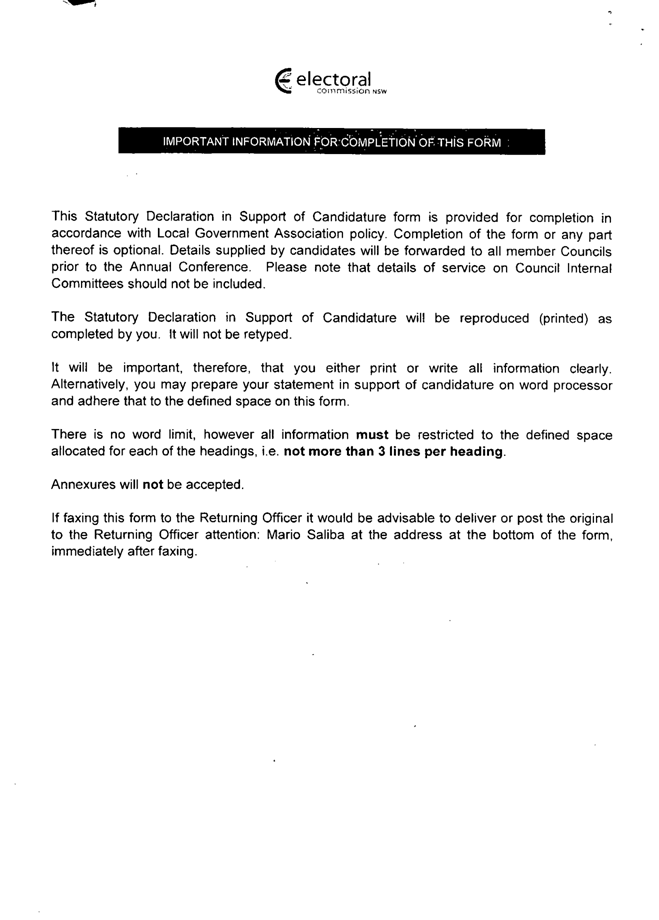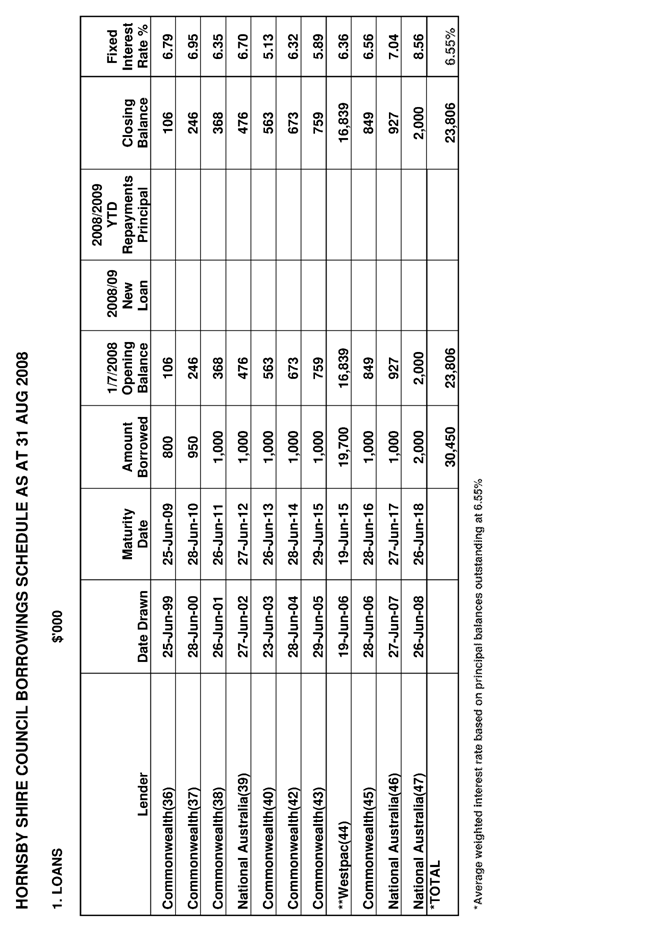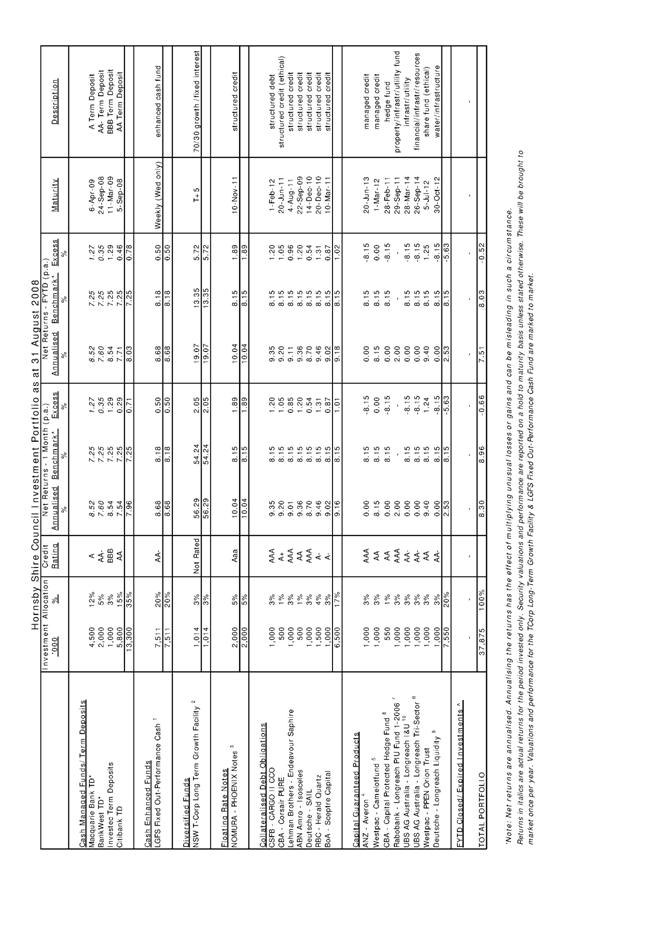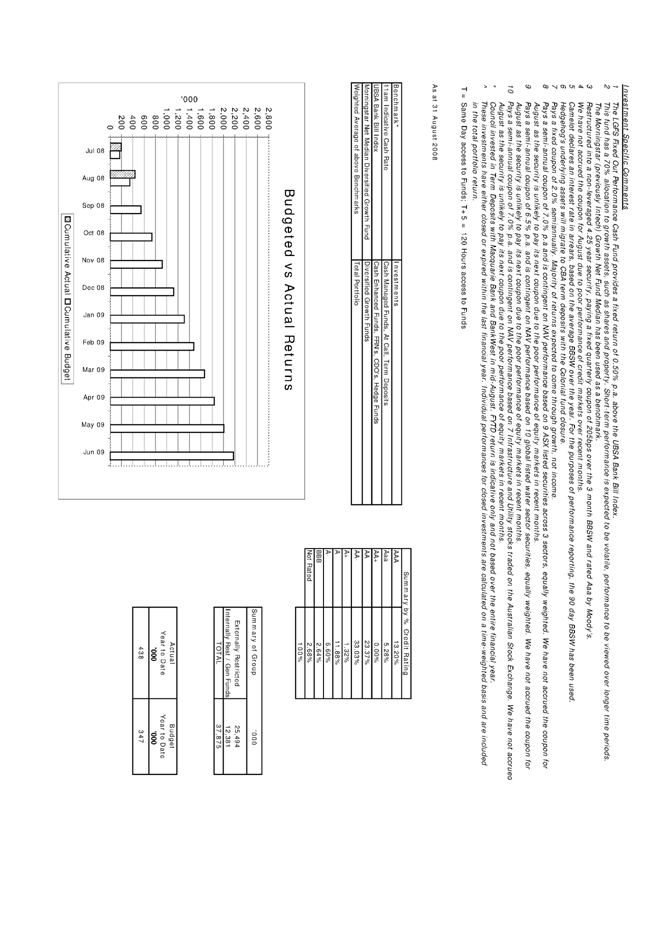|
Hornsby Shire
Council
|
Attachment to
Report No. CC87/08 Page 9
|
Executive
Manager's Report No. CC44/08
Corporate
& Community Division
Date
of Meeting : 09/07/2008
Item No: Subject:
|
19
|
LOCAL GOVERNMENT ASSOCIATION
CONFERENCE 2008 - SUBMISSIONS OF MOTIONS AND NOMINATIONS OF VOTING DELEGATES
|
EXECUTIVE SUMMARY
The
2008 Annual Conference of the NSW Local Government Association (LGA) will be
held in Broken Hill from 25 October to 29 October 2008. The Conference provides
an opportunity for Council to submit motions for debate and decision by
delegates from member local governments across New South Wales. Each Division
of Council has been provided with an opportunity to prepare draft motions for
consideration at this Meeting. The motions are either based on resolutions made
by Council over the past 12 months or are issues which ExCo or the individual
Divisions consider appropriate. The Report also provides information about the
proposed method of determining Council's delegates for the Conference, noting
that the first meeting of the new Council elected on 13 September 2008 will
occur on 8 October 2008.
PURPOSE/OBJECTIVE
The
purpose of this Report is to formally adopt motions to be submitted to the Annual
Conference by Council and to provide information about the nomination of
Council's voting delegates.
DISCUSSION
At
the time of writing this Report, a Conference brochure has yet to be
distributed by the LGA to member councils.
Council officers have, however, contacted staff of the LGA who have
verbally advised that relevant information is expected to be distributed to
councils in early July 2008. Those staff have also advised that the general
guidelines for the Conference will remain the same as in previous years and
confirmed the dates applicable to the submission of motions and the nomination
of voting delegates. Should there be any significant variations evident once
the Conference material is received, Councillors will be advised of such changes.
Delegates
for the Conference
Voting
delegate entitlements for each council at the LGA Annual Conference are
determined by population of the council area using Australian Bureau of
Statistics figures. As Hornsby Shire Council's population is greater than
150,000, it is entitled to seven voting delegates. Council would normally
determine its voting delegates for the Conference at the same time as adopting
motions to be submitted to the Conference i.e. as part of consideration of this
Report. However, noting that the local
government elections are to be held on 13 September 2008, it will not be
possible for Council to determine its voting delegates until the first meeting
of the new Council which is scheduled to be held on 8 October 2008. It is
recommended, therefore, that a report be prepared for Council's consideration
at the 8 October 2008 Meeting seeking the nomination of Council's voting
delegates for the Conference. This will
also allow Council to advise the LGA of the voting delegates prior to their
deadline of 13 October 2008.
Motions
for the Conference
The
closing date for submission of motions is 11 August 2008. As such, it is recommended that Council make a
determination at tonight's meeting of motions to be submitted for consideration
at the LGA Conference.
The
LGA have previously advised that motions which seek to vary existing policy or
address new or emerging policy issues will be classified as Category One
motions and will be scheduled for debate at the Conference by inclusion in the
Business Paper. All other motions, which reaffirm existing policy or call for
actions to be taken in relation to existing policy, will be classified as
Category Two motions. They will also be included in the Conference Business
Paper and may be individually brought forward to be debated with the agreement
of the Conference, otherwise they will be referred to the Executive of the
Association for consideration. Where
appropriate, some motions may be actioned before the Conference.
The
LGA's 2007 Annual Conference information booklet required that each motion
submitted by Council for debate at the Conference be formatted in the manner
indicated below. Following discussions
with the LGA it is apparent that a similar format will apply for the 2008
Conference. A copy of the 2008
information booklet will be placed on file when received.
• Subject/Heading
• Motion Text -detailing the proposed addition, deletion or introduction of policy
• Note From Council - a summary, explaining the reason for
submitting the motion and how it alters or adds to existing policy
• Detailed Supporting Case - this should be on a separate
page giving reasons for raising the issue. It will be used by the LGA to
progress the matter once Conference has dealt with it. The Supporting Case will not be included in
the Business Paper.
(N.B.
Only the Subject/Heading, Motion Text and Note From Council are
included in the Conference Business Paper)
__________________________________
The
following is a set of motions which have been prepared by the relevant Council
Divisions for consideration by Council. They are either based on resolutions
made by Council over the past 12 months or are issues which ExCo or the
individual Divisions have considered appropriate for submission.
Subject: Sustainable Local
Infrastructure Funding
Motion Text
That the Local Government
Association:
1. Request its members, particularly those in the Greater
Metropolitan Area, to withdraw their commitment to housing and employment
targets until a new and sustainable infrastructure funding framework is
developed and adopted by the State Government and the Association; and
2. That the new framework be based on local government accountability
and less Ministerial control, and that it involve either:
a) a reformed rate pegging approach with IPART recommending rate
rises; or
b) councils developing endorsed long term infrastructure funding
and management plans which will justify rate rises, with expenditure overseen
by an independent body such as the Auditor General.
Note
from Council
The
almost insurmountable problem of financing an immense backlog in infrastructure
provision, maintenance and renewal requires a new and sustainable funding
framework with growth capacity, greater local government control and
accountability and less State Government intervention.
Detailed
Supporting Case
There
is overwhelming and undisputed evidence that local government in Australia, and
in particular NSW, faces almost insuperable challenges in coping with the
problem of financing an immense backlog in infrastructure provision,
maintenance and renewal. The State Government’s decision to rush through
changes to the setting and collection of development contributions without
considering their long term impact can only compound the challenges. This is
particularly relevant to the provision in a timely way of the services and
facilities required by the new population and employees targeted by the
government, particularly for the Greater Metropolitan Area.
The
State Government’s decision is particularly short-sighted given the:
• findings and recommendations of
the 2006 Percy Allan report;
• Australia 2020 Summit’s conclusion that one of the principal
determinants of community strength is the adequacy of the physical and social
infrastructure in local communities;
• Productivity Commission’s 2008 finding that the State Government has
chosen to have more influence on local government revenue raising capacity than
other State Governments (with deleterious consequences) and the suggestion for
periodic reviews of the restrictions imposed on local government
A
review of local and national public inquiries into local government
infrastructure funding supports Professor Phibbs of UWS in his assertion that
the present arrangements are broken. While Section 94 has operated reasonably
well over 30 years, recent experience suggests that it is no longer a
sustainable funding source. Other available funding sources, such as rates,
have limited growth capacity particularly with Ministerial control. The Government has also been reluctant to
approve special levies, imposing tortuous hurdles to their timely
implementation. Special purpose grants are largely short term, are
unpredictable and usually require matching funds.
It is
time for a new and sustainable funding framework based on greater
accountability by local government and less control by the State Government.
_______________________________________
Subject:
Increase in Public Library Funding
Motion
Text
That
the Local Government Association request a meeting with the Premier of NSW to
seek an increase in State Government funding for public libraries so that they
are able to continue to provide vital services and programs to the community.
Detailed
Supporting Case:
The
NSW Public Library Network is a cohesive, state-wide network based on
cooperation between local councils, public libraries and the State Library of
NSW. Local government meets more than 90% of the costs of the Network. NSW State Government funding of public
libraries has fallen drastically in recent decades, from 23% in 1980 to 9% in
2007/08. Such a percentage contribution in 2007/08 compares unfavourably to
funding provided to public libraries by other State Governments. For example, in Victoria, which operates a
similar public library system to NSW, public libraries received funding from
their State Government totalling 20% of their expenditure. Also, in 2007/08,
the Victorian state government budgeted
for the provision of an extra $2 million to public libraries.
Public
libraries play a vital educational, cultural and social role within the
community. Libraries provide services
and programs to a wide range of groups within the community. There is increasing demand from the community
for services and programs along with pressure from changing demographics. These
include the provision of technological
infrastructure necessary to ensure equitable access to new technologies and
e-government initiatives, and the provision of resources to support literacy
programs such as the Premier's Reading Challenge. These all place escalating pressure on an already
limited budget.
Only
with increased funding from the NSW government can public libraries deliver
programs that meet community and government needs.
_______________________________________
Subject: Provision of Appropriate
Market Rental Funds or Significant Capital Funds to Grant Funded Programmes in
Order to Reduce their Reliance on Local Government to Subsidise Rental Costs.
Motion Text
That the Local Government Association call on the NSW and Federal
Governments to increase rental and capital funding provided to non-government
and community based organisations that auspice and implement state and
federally funded programmes such that the funds provided meet market rental
requirements.
Note from Council
Hire
fees and charges for Council owned and operated facilities are heavily
subsidised and reflect a partial cost recovery ethos.
The
lack of funding associated with rental or capital costs within available grants
places a requirement on non-government and community based organisations that
auspice and implement grant funded programmes to seek fee waivers or free
accommodation from local government or other organisations in order to
accommodate the funded services.
_______________________________________
Subject:
Use of Variable Message Signs in Road Reserves
Motion
Text
That
the Local Government Association seek alterations to the relevant legislation
to limit the use of variable message signs in road reserves to matters associated
with road safety and traffic management only.
Note
from Council
Council
has become aware of the increasing use of the variable message signs in road
reserves for advertising purposes. These
signs are regularly placed in locations of high traffic concentration, such as
at intersections, where the variable messages displayed (sometimes flashing
with moving text) can easily distract drivers from the driving task. Further, drivers have become accustomed to
seeing such signs used to convey messages relating to road conditions and/or
safety matters. The short term nature of
many advertising displays means that it is not feasible to pursue the removal
of these signs under existing environmental legislation, and enforcement action
(fines, etc) whilst providing a deterrent, will not create a safer environment
for drivers. It is understood that the
Tasmanian government has recently enacted legislation that achieves this
purpose. There is no objection to the
display of such signs in locations that are not visible from a road.
_________________________________
Subject:
Bus Stops - Compliance with Disability Discrimination Act (DDA)
Motion
Text
That
the Local Government Association make representations to the State Government
requesting financial support to councils when implementing improvements to bus
stops required to ensure they are DDA compliant.
Note
from Council
Councils
are in the process of ensuring that bus stops in their areas comply with the
requirements of the Disability Discrimination Act (DDA). The provision of suitable public transport
facilities in a council area has become an increasing responsibility of
councils notwithstanding that the Ministry of Transport actively controls bus
routes and public transport matters. The
increasing emphasis on the use of public transport as a substitute for private
vehicle based transport imposes additional cost considerations on councils
where such costs have not previously been required. For many councils the cost of upgrading bus
stops in their area to full compliance with DDA requirements is likely to be
significant. Financial assistance would
be seen as support by the state for councils' actions in delivering improved
public transport which is essentially a state government responsibility.
___________________________________
Subject:
Enforcement - Moving Traffic Offences
Motion
Text
That
the Local Government Association make representations to the State Government
to provide council rangers with authorisation to enforce ‘No Right Turn’ and ‘U
Turn over barrier lines' offences in school zones.
Note
from Council
Currently,
Council rangers are not authorised to enforce ‘No Right Turn’ and ‘U Turn over
barrier lines' offences. The active
patrolling of school zones and parking activities near schools is seen as a
priority by many councils. Council
rangers are regularly on site and may enforce parking provisions in association
with local school communities. The
ability to also enforce certain moving traffic offences in school zones would
provide additional encouragement for safe driving and parking practices in
these critical locations. It is
understood that local police may have other higher priority matters to attend
to at times when pedestrian activity at schools is high, and the flexibility
available to council rangers to enforce such offences would contribute to
improved safety at schools.
_____________________________________
Subject: Disabled Parking Spaces
Motion
Text
The
Local Government Association support the introduction of time restricted
disabled parking spaces in certain limited circumstances.
Note
from Council
Council
wishes to provide short term parking for the disabled in close proximity to
shops and other locations where short term parking is desirable. Current legislation discourages Council from
taking such action, as the provision of such parking for the disabled could be
used for all day parking by commuters, contrary to its desired function. The added flexibility created by establishing
a separate class of disabled parking where time restrictions can be implemented
in consultation with local Access Committees, would be to the advantage of the
disabled community generally.
__________________________________
Subject: Amendment of the Fringe
Benefits Tax Assessment Act
Motion Text
That the Local Government Association lobby the Commonwealth Government
to amend the Fringe Benefits Tax
Assessment Act 1986 to encourage more sustainable transport practices.
Note from Council
Fringe benefits tax concessions on employer-provided
motor vehicles promotes greater usage and results in higher greenhouse
emissions. Council is calling on the
Federal government to encourage greater use of public transport by exempting it
from fringe benefits tax and to amend the Fringe Benefits Tax Assessment Act
1986 to promote more sustainable vehicle use.
Detailed Supporting Case
Fringe benefits tax on employer-provided motor
vehicles currently encourages people to drive further which is inconsistent
with attempts to promote greenhouse friendly practices of reduced vehicle use
and increased public transport use.
According to the National Transport secretariat, company cars constitute
40% of cars during peak hour and 18% of total car trips. In many councils and
companies cars are offered to staff as a part of their salary package and
require them to travel 25,000 kilometres each year in order to achieve a lower
tax rate. If a staff member is having
difficulty reaching the specific amount of kilometres they often swap vehicles
with someone who drives more often or travels greater distances to reach the
required mileage.
This fringe benefits tax arrangement arose out of
an attempt to save smaller companies from having to estimate what proportion of
their company vehicle use was for business purposes and what proportion was for
personal use by filling out time-consuming logbooks. The system changed by assuming that the more
kilometres travelled the greater the proportion of business use, and the fringe
benefits tax payable should consequently be lower, for example:
- less than 15,000 kilometres, 26% is considered to
be personal and the fringe benefits tax is 26% of the value of the car;
- between 15,000 and 25,000 kilometres, the fringe
benefit tax is 20%;
- more than 40,000 kilometres, the fringe benefits
tax is 7% of the value of the car.
Employer-provided car parking is also exempt from
fringe benefits tax in many situations, despite the clear financial benefit
that it provides to employees. If public
transport tickets or bicycles are offered as fringe benefits, they are taxed at
the full fringe benefits tax rate of 48.5% - clearly inequitable with the 7-26%
rate applied to cars. In effect the
government is encouraging driving motor vehicles and discouraging cycling or
public transport use and therefore contributing to higher pollution and
greenhouse gas emissions.
Some examples of
current practices around the world to encourage environmentally friendly
transport use are:
- The UK, who previously used the same method as is
currently used in Australia, now calculates fringe benefits tax based on the amount of CO2 that a car emits -
the more CO2 emitted, the higher the tax.
- In the USA, employers can give their employees
tax-free public transport vouchers, passes or fares valued at up to $100 each
month. A study carried out in
Canada found that these amendments would result in a net benefit from a
reduction in required road maintenance, air pollution and traffic
congestion.
Council is calling on the Federal government to
encourage greater use of public transport by exempting public transport from
fringe benefits tax and to amend the Fringe Benefits Tax Assessment Act 1986 to
encourage more sustainable vehicle use.
BUDGET
Funds
have been allocated in the 2008/09 Budget for attendance at the Annual
Conference.
POLICY
Attendance
at the Annual Conference will be in accordance with the Councillors' Expenses
and Facilities Policy. There are no other policy implications other than those
raised in the context of the Local
Government Association policy.
CONSULTATION
Consultation
has been undertaken with each Division in respect of possible motions for the
Conference. Regard has also been given to Council resolutions over the past 12
months
TRIPLE BOTTOM LINE SUMMARY
Triple
Bottom Line is a framework for improving Council decisions by ensuring
accountability and transparency on social, environmental and economic
factors. It does this by reporting upon
Council’s strategic themes.
As
this Report simply provides Council with information and does not propose any
actions which require a sustainability assessment, no Triple Bottom Line
considerations apply.
RESPONSIBLE OFFICER
The
officer responsible for the preparation of this Report is the Administration
Coordinator - Ruth Robins who can be contacted on 9847 6011.
RECOMMENDATION
THAT
Council:
1. Endorse
the submission of motions included in this Report to the Local Government
Association for consideration at the 2008 Annual Conference.
2. Determine
if it wishes to submit any additional motions for discussion at the 2008 Annual
Conference of the Local Government Association.
3. Note
that a further report will be prepared for consideration at the 8 October 2008
Ordinary Meeting to determine voting delegates for the 2008 Annual Conference
of the Local Government Association.
ROBYN ABICAIR GARY
BENSLEY
Manager Executive
Manager
Administration Services Branch Corporate and
Community Division
Attachments: NIL
File(s) required for Meeting: F2004/09974
|
Hornsby Shire
Council
|
Attachment to
Report No. WK58/08 Page 45
|
Our
Reference: F2007/00096 &
F2008/00492
Contact
Person: Lawrence Nagy
Hours: 9:00am to 4:30pm
Telephone: 9847 6616
Fax: 9847 6559
18
September 2008
The Director
General Purpose Standing Committee No. 4
Parliament House
Macquarie Street
SYDNEY
NSW 2000
Dear Sir/Madam
Transport needs of Sydney’s North-West Sector (Inquiry)
Thank you for the invitation to make a submission
to the General Purpose Standing Committee Number 4 Inquiry into the transport
needs of Sydney’s
North West Sector.
The Department of Planning has previously
consulted with local government and community stakeholders during
preparation of the North West Sub Regional Strategy. This strategy was prepared
to guide land-use planning in the region until 2031. Key directions of the strategy include
implementation of the planned North West Rail Link and integrating transport
and land use opportunities.
The key directions of
North West Sub Regional Strategy and those of the broader Metropolitan Strategy
have already provided sufficient insight into the requirements and plans for
integrated transport systems in the North West Sector. What is required now to advance the key
directions of the strategy is the development of an infrastructure spending
strategy. Council is concerned that the
current inquiry will only delay implementation of key directions of the
strategy, in particular the time line for providing the North West Rail Link.
Notwithstanding,
Council wishes to make the following submission regarding aspects of Sydney’s North West Sector
transport needs:
· The
redevelopment of Epping Station without supporting traffic flow planning and
commuter parking facilities.
Council is concerned
that the State Government has recently completed redevelopment of Epping
railway station for the Epping Chatswood rail link without any provision for
increased commuter parking. TIDC is now in the process of evaluating options
for a new North West Metro station at Epping and there is no indication that
parking will be considered in any detail.
Page 2
This is a serious
issue as local businesses are affected by traffic congestion and limited
parking availability. Commuter parking has swamped on street parking around Epping
and Council is under pressure to remove parking to improve traffic flow.
Council’s ability to provide parking for existing businesses is severely
limited by the capital cost and lack of suitable sites for off street parking.
Bus services are regularly delayed by traffic congestion in Langston Place
despite the provision of new traffic signals as part of the Epping station
upgrade. Until the problems on Beecroft Road and Epping Road are addressed,
vehicle access around Epping will remain an issue for local businesses as well
as commuters.
Council submits that a co-ordinated approach by Council, the RTA,
Railcorp/TIDC and STA is required to ensure traffic flow and commuter parking
generated by major rail projects is managed effectively.
· The
need for completion of the Epping to Parramatta rail line as being essential to
cater for the continued growth of the North West Sector. This will provide full access between
Parramatta/ Castle Hill/ Hornsby/ the City/ Chatswood and Macquarie
University/Business Park.
A number of studies
have confirmed that a large proportion of trips through Hornsby Shire involve
Parramatta, Macquarie Park, Chatswood, North Sydney and Sydney CBD as an origin
or destination. Traffic congestion on the Cumberland Highway makes bus services
slow and unreliable and the railway link from Carlingford is indirect and
involves a change at Clyde.
The current Epping to
Chatswood rail link represents only part of the original Parramatta to
Chatswood rail link proposal and completing the deferred section between
Parramatta and Epping will be an enormous benefit in reducing demand on
existing transport and other infrastructure serving Parramatta CBD and Sydney
CBD.
Council submits that it is essential that the Parramatta
to Epping section of the Parramatta to Chatswood
rail link be a high priority to consolidate transport infrastructure in north
western Sydney
and ensure the transport infrastructure can meet the demands of the full development potential of the area.
· That
if the North West Metro option proceeds, (in contrast to the heavy rail
originally proposed for this link), the continuation and integration of this
Metro Line must be made a priority.
Council is concerned
that given the history of the original Parramatta Chatswood rail link proposal
the full value of the current North West Metro proposal will not be realized
unless the Epping to Sydney CBD section of the Metro is available. Residents
and businesses in North Western Sydney will not have direct and convenient
public transport access to Chatswood, North Sydney and the city even after the
Epping Chatswood heavy rail link is operating because there will be modal
changes required between the Metro and heavy rail. Each change adds time and
reduces convenience, particularly when connections are missed.
Page
3
Council submits that a heavy rail connection between the north west and the city would have provided a direct
connection through Macquarie
Park to Chatswood. Now
that a Metro system for the north west is
proposed it is essential that a through link to Sydney CBD be provided so that Metro
commuters need not change modes.
· Any
future/further development of Epping Station to accommodate the North-west
Rail, regardless of the form it may take, must include meaningful community
consultation.
The consultation
process for the North West Rail Link did not take into account the
administrative requirements of Council. In particular the timing of public
meetings and deadlines for submissions adopted by NWRL left little time for Council
officers to investigate issues and report to Council prior to Council adopting
a position on an issue.
The ability of the
community to make comment and engage in the decision making process
independently of Council was also compromised by the short time frames and
inappropriate consultation methods adopted by the State.
Council submits that future consultation by state government agencies
must include a factor to allow Council and the community to make a properly
considered response.
· Sufficient
"kiss and drop" facilities to be included at all stations along any
proposed new rail lines, with other (bus etc) public transport linkages and
parking facilities being provided where assessed (in consultation with the
local community) to be appropriate.
Access to Epping
railway station relies heavily on road space formerly used by local businesses.
Bus and taxi operators regularly request more parking and complain about delays
to schedules caused by congestion. Bus operators are also requesting visitor parking
be removed from Epping CBD to improve traffic flow. TIDC has not provided
additional parking to compensate for the loss of prime visitor parking in the
Epping Town Centre due to the reconstruction of the bus interchange.
Council submits that as developer, the State Government should ensure
local residents and businesses are not adversely impacted by increased traffic
congestion and loss of on street
parking and that facilities for commuters be provided and clearly separated
from facilities.
· Reiteration
of Council’s support for a North-West Rail line to include a station under
Carlingford Court Shopping Centre, referencing the proposed additional
dwellings in the adjacent precinct within Baulkham Hills Council boundaries,
which will have a severe impact on traffic and parking within Hornsby Shire.
In order to meet
State Government population targets both Baulkham Hills and Hornsby Councils
regard the area around Carlingford
Court shopping centre and Carlingford railway
station as appropriate for higher density redevelopment. More efficient peak
hour links are required to ensure local residents and businesses have direct
access between Epping, Macquarie Park, Chatswood, North Sydney
and Sydney CBD.
Page
4
During the Preferred
Project Report consultation, Council requested that the North West Rail/Metro
route be amended to include a station near Carlingford Court. The heavy rail
proposal would tap into an area earmarked for significant future population
growth with only a moderate increase in cost and travel time over the proposed
route.
Council submits that the heavy rail option still has benefits for
residents living in north western Sydney and that an amended route via
Carlingford should be further considered.
· Concern
with pace of providing planned infrastructure development generally.
In addition to the
above issues, Council also submits that in spite of the acknowledged
significant traffic growth in the region, expenditure on roads has not matched
this growth. As a consequence, there are
severe capacity problems and congestion experienced at critical locations along
main arterial routes. The RTA is aware
of the problems that are being experienced in the north western part of the
Shire and have previously commissioned the Old North/New Line Road Strategic
Route Development Study. Ten years have
passed since this study was completed and yet most of the recommendations of
this study have not been implemented.
Other notable locations in the North
West section of the Shire where severe traffic
problems are experienced include Boundary
Road, Castle
Hill Road, the intersection of Boundary Road with Pennant Hills Road and the intersection
of New Line Road
with Shepherds Drive/County Drive. Problems experienced at these locations severely affect bus
services and the problems will not go away on their own unless specific and
targeted measures are implemented to address them. Council considers that the
measures proposed under the Strategic Bus Corridors Program are extremely
simplistic, for example, providing Bus Early Start facilities on roads which
currently are so congested that getting the bus to the head of the queue would
require demolishing kilometres of housing to provide an extra lane.
A comprehensive review
of traffic and transport requirements should be undertaken to identify
bottleneck locations in the regions and how they should be addressed. The review should include all the critical
junctions along arterial and sub arterial routes such as the intersections of Boundary Road with Pennant Hills Road
and New Line Road
with Shepherds Drive. Pedestrian access across these roads to bus
stops should be included as a specific term of reference in any review.
Council is requesting
the Committee to consider the issues raised in this submission and should
report on the:
1. Need to expedite
implementation of key directions of the Sydney North West Strategy, in
particular the planned North West Rail Link/Metro.
2. Need to integrate all
transport systems or modes in the region including road, rail and bus links.
3. Requirement to develop an
infrastructure spending strategy of identified works.
4. Need to develop a schedule
of works and a time line of the program of implementation.
Page
5
· Conclusion
While Council
acknowledges the efforts of the State Government to meet the transport needs of
residents and businesses in Sydney’s North West, successive state governments
have allowed extensive development to occur prior to efficient transport
infrastructure being provided. A rail service to the North West Sector has been
promised by successive governments, and its provision is long overdue. Council is committed to ensure its local
needs are included in any transport infrastructure proposals.
The Committee is invited
to observe first-hand, the ongoing congestion that occurs on arterial roads in
the Shire, particularly during peak hours.
If you require
further information please contact Council’s Manager Traffic and Road Safety, Lawrence Nagy, on 9847 6616.
Yours faithfully
R J BALL
General Manager









